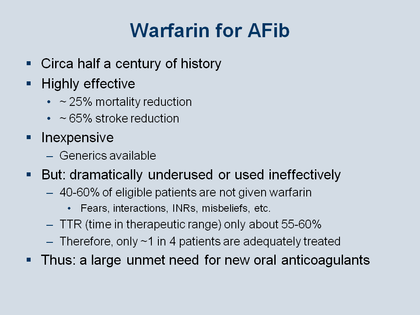James A. Reiffel, MD - Novel Oral Anticoagulants - Figure 2
Warfarin for AFib
Dr. Rothman has reviewed many of the important facts about warfarin in the preceding presentation. Warfarin has been available for half a century; it is highly effective at reducing mortality, and it is particularly effective for reducing the risk for stroke in patients with nonvalvular AFib. It is inexpensive, generics are available, and yet it is dramatically underused or used ineffectively. For the last decade or more, in almost every study published about its use, 40–60% of eligible (i.e., appropriate) patients were not prescribed warfarin because of fears about its side effects, its interactions with other compounds or foods, unstable international normalized ratios (INRs) during administration – all impediments to prescription amplified by other misbeliefs about this agent. Finally, even when warfarin is prescribed in adherent patients, the time in therapeutic range (TTR) for the serum warfarin values turns out to be only about 55–60% of the time. The result is that only about 1 in 4 patients are adequately treated, and thus there is a large unmet need for better approaches to achieving adequate anticoagulation in this cohort of patients.
Reiffel JA. Am J Med 2013; 126: 00-00.

